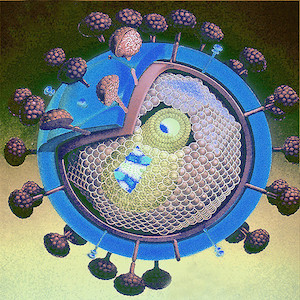Stanford's Peter S. Kim, PhD, was recently elected to the National Academy of Engineering, making him one of only 20 people who are members of all three National Academies (the other two are Medicine and Science). Stephen Quake, PhD, a bioengineer here, is also a member of all three academies.
This honor is particularly fitting for Kim, who joined Stanford in 2014 to be part of the new interdisciplinary institute Stanford ChEM-H, which bridges the schools of medicine, engineering and humanities & sciences for research in human health. Kim had spent a decade as president of Merck Research Laboratories and hopes that in his return to academic research his group will be able to help create a vaccine for HIV.
I talked to Kim recently about why he thinks he'll succeed where so many have failed in their efforts to develop an HIV vaccine, and the importance of working across disciplines:
How is your approach to creating an HIV vaccine different from ones that haven't been successful?
In over 30 years of intense work by many people to try and come up with a vaccine, none has succeeded. That's in large part because the virus can mutate very quickly. It can change and therefore escape an antibody. The approach that we're taking is to target a part of HIV that is normally buried but becomes exposed during the infection process. This region is highly conserved - it is 90 percent identical between all HIV strains.
If this region doesn't mutate often why haven't other people tried to target it?
It is unprecedented to make a vaccine against a region of a protein that is only exposed briefly. People are skeptical because the vaccine has to be there right at the moment that the virus is infecting the cell.
What gives you confidence the approach will work?
There's an FDA-approved drug, called Fuzeon, that binds this same region and has been shown to be effective in people. That drug isn't widely used because it has to be injected, but it validates our idea that targeting this transiently exposed part of the protein can be effective at fighting the virus in humans.
How far along are you?
We've shown that we can elicit antibodies in animals that are capable of inhibiting HIV in a lab dish. Thus, we know that our vaccine candidates can generate antibodies against the virus, and that those antibodies recognize and fight the virus. But, we still need to generate a much stronger inhibitory response before we test it in people.
You're now a member of the three academies that also represent the academic interests of ChEM-H, which brought you to Stanford. Do you think spanning disciplines helps in your work?
The research that we do is greatly enhanced by having the proximity of engineering, medicine and science at Stanford. We study things as basic as the molecular structures of viral proteins. Ultimately, we need to understand how the human immune system creates antibodies against these proteins. This work is greatly facilitated by engineering methods to determine the DNA sequence of single immune cells. In the future, we would also love to see what is occurring at a single molecule level when a virus infects a cell. To do that will require bringing together world class engineering, science and medicine.
Previously: Research investment needed now, say top scientists and Stanford ChEM-H bridges chemistry, engineering and medicine
Image of an HIV particle by AJ Cann




